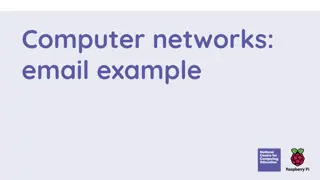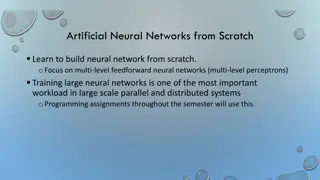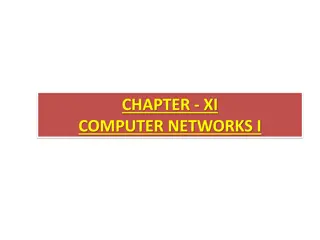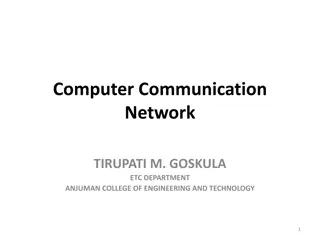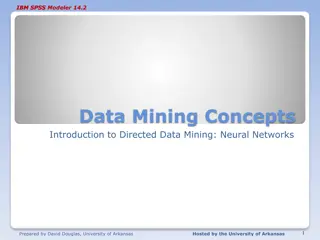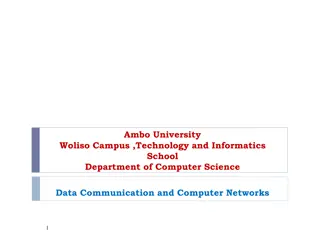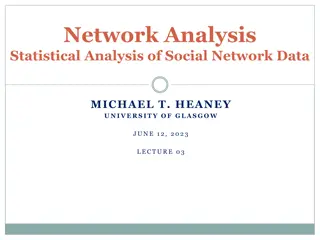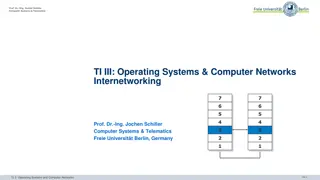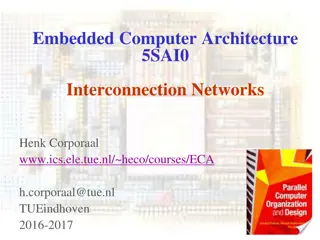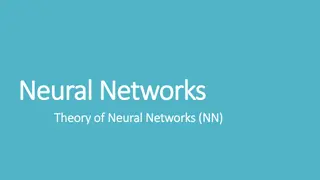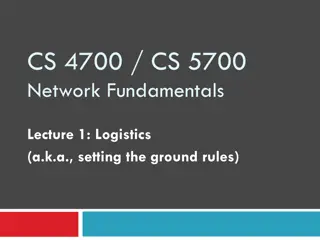Computer Networks
Immersive exploration of the American Western Frontier in the 19th century, highlighting the impact of mining booms, the unique lifestyle of ranchers and farmers, and the struggles faced by Native American tribes such as the Sioux, Comanche, and Blackfeet. Discover the cultural diversity, challenges, and conflicts that shaped this pivotal era of American history.
Download Presentation

Please find below an Image/Link to download the presentation.
The content on the website is provided AS IS for your information and personal use only. It may not be sold, licensed, or shared on other websites without obtaining consent from the author.If you encounter any issues during the download, it is possible that the publisher has removed the file from their server.
You are allowed to download the files provided on this website for personal or commercial use, subject to the condition that they are used lawfully. All files are the property of their respective owners.
The content on the website is provided AS IS for your information and personal use only. It may not be sold, licensed, or shared on other websites without obtaining consent from the author.
E N D
Presentation Transcript
Computer Networks By Dr. M. Kalpana Devi Professor MCA Department SITAMS, Chittoor
UNIT - 1 : 1.1 Uses of Computer Networks 1.1.1 Business Applications 1.1.2 Home Applications 1.1.3 Mobile Users 1.1.4 Social Issues 1.2. Network Hardware 1.2.1 Local Area Networks 1.2.2 Metropolitan Area Networks 1.2.3 Wide Area Networks 1.2.4 Wireless Networks 1.2.5 Home Networks 1.2.6 Internetworks 1.3 Network Software 1.3.1 Protocol Hierarchies 1.4. References Models 1.4.1 The OSI Reference Model 1.4.2 The TCP/IP Reference Model 1.4.3 A Comparison of the OSI and TCP/IP Reference Models 1.4.4 A Critique of the OSI Model and Protocols 1.4.5 A Critique of the TCP/IP Reference Model Introduction to Computer Networks
1.5 The Physical Layer 1.5.1 Guided Transmission Media 1.5.1.1 Magnetic Media 1.5.1.2 Twisted Pair 1.5.1.3 Coaxial Cable 1.5.1.4. Fiber Optics 1.5.2 Wireless Transmission 1.5.2.1. The Electromagnetic Spectrum 1.5.2.2 Radio Transmission 1.5.2.3 Microwave Transmission 1.5.2.4 Infrared and Millimeter Waves 1.5.2.5 Lightwave Transmission 1.6 Communication Satellites 1.6.1 Geostationary Satellites 1.6.2 Medium-Earth Orbit Satellites 1.6.3 Low-Earth Orbit Satellites
COMPUTER NETWORKS A computer network is a system in which multiple computers are connected to each other to share information and resources. The physical connection between networked computing devices is established using either cable media or wireless media. The best-known computer network is the Internet.
Advantages of Computer Networks 1. File sharing The major advantage of a computer network is that is allows file sharing and remote file access. A person sitting at one workstation that is connected to a network can easily see files present on another workstation, provided he is authorized to do so. 2. Resource sharing All computers in the network can share resources such as printers, fax machines, modems, and scanners. 3. Better connectivity and communications It allows users to connect and communicate with each other easily. Various communication applications included e-mail and groupware are used. Through e-mail, members of a network can send message and ensure safe delivery of data to other members, even in their absence. 4. Internet access Computer networks provide internet service over the entire network. Every single computer attached to the network can experience the high speed internet.
5. Entertainment Many games and other means of entertainment are easily available on the internet. Furthermore, Local Area Networks (LANs) offers and facilitates other ways of enjoyments, such as many players are connected through LAN and play a particular game with each other from remote location. 6. Inexpensive system Shared resources mean reduction in hardware costs. Shared files mean reduction in memory requirement, which indirectly means reduction in file storage expenses. A particular software can be installed only once on the server and made available across all connected computers at once. This saves the expense of buying and installing the same software as many times for as many users. 7. Flexible access A user can log on to a computer anywhere on the network and access his files. This offers flexibility to the user as to where he should be during the course of his routine. 8. Instant and multiple access Computer networks are multiply processed .many of users can access the same information at the same time. Immediate commands such as printing commands can be made with the help of computer networks.
Disadvantages of Computer Networks 1. Lack of data security and privacy Because there would be a huge number of people who would be using a computer network to get and share some of their files and resources, a certain user s security would be always at risk. There might even be illegal activities that would occur, which you need to be careful about and aware of. 2. Presence of computer viruses and malwares If even one computer on a network gets affected by a virus, there is a possible threat for the other systems getting affected too. Viruses can spread on a network easily, because of the inter- connectivity of workstations. Moreover, multiple systems with common resources are the perfect breeding ground for viruses that multiply. 3. Lack of Independence Since most networks have a centralized server and dependent clients, the client users lack any freedom whatsoever. Centralized decision making can sometimes hinder how a client user wants to use his own computer.
4. Lack of Robustness As previously stated, if a computer network s main server breaks down, the entire system would become useless. Also, if it has a bridging device or a central linking server that fails, the entire network would also come to a standstill. 5. Need an efficient handler For a computer network to work efficiently and optimally, it requires high technical skills and know-how of its operations and administration. A person just having basic skills cannot do this job. Take note that the responsibility to handle such a system is high, as allotting permissions and passwords can be daunting. configuration and connection is very tedious and cannot be done by an average technician who does not have advanced knowledge. Similarly, network
USESOF COMPUTER NETWORKS Business Applications: To keep track of inventories, to monitor production and do the payroll in the Companies that have separate computers. Initially, each of these computers may have worked in isolation from the others. At some point, management may have decided to connect them to be able to extract and correlate information about the entire company. More important thing in this context is sharing physical resources such as printers, scanners, and CD burners, and sharing information. A second goal of setting up a computer network has to do with people rather than information or even computers. Yet another form of computer-assisted videoconferencing. Using this technology, employees at distant locations can hold a meeting, seeing and hearing each other and even writing on a shared virtual blackboard. A third goal for increasingly many companies is doing business electronically with other companies, especially suppliers and customers. A fourth goal that is starting to become more important is doing business with consumers over the Internet. Airlines, bookstores, and music vendors have discovered that many customers like the convenience of shopping from home. communication is
Home Applications Initially, for word processing and games, but in recent years that picture has changed radically. Probably the biggest reason now is for Internet access. Some of the more popular uses of the Internet for home users are as follows: 1. Access to remote information. 2. Person-to-person communication. 3. Interactive entertainment. 4. Electronic commerce. 1. Access to remote information comes in many forms. It can be surfing the World Wide Web for information or just for fun. Information available includes the arts, business, cooking, government, health, history, hobbies, recreation, science, sports, travel, and many others.
2. Another type of person-to-person communication often goes by the name of peer-to-peer communication, to distinguish it from the client-server model. In this form, individuals who form a loose group can communicate with others. Every person can, in principle, communicate with one or more other people; there is no fixed division into clients and servers. 3. Our third category is entertainment, which is a huge and growing industry. The killer application here is video on demand. A decade or so hence, it may be possible to select any movie or television program ever made, in any country, and have it displayed on your screen instantly. Live television may also become interactive, with the audience participating in quiz shows, choosing among contestants, and so on. 4. Our fourth category is electronic commerce in the broadest sense of the term. Home shopping is already popular and enables users to inspect the on-line catalogs of thousands of companies. Some of these catalogs will soon provide the ability to get an instant video on any product by just clicking on the product's name. After the customer buys a product electronically but cannot figure out how to use it, on-line technical support may be consulted.
Mobile Users Mobile computers, such as notebook computers and personal digital assistants (PDAs), are one of the fastest growing segments of the computer industry. Many users of these computers have desktop machines back at the office and want to be connected to their home base even when away from home or en route. There is a lot of interest in wireless networks. Wireless networks are also important to the military. Another area in which wireless could save money is utility meter reading. If electricity, gas, water, and other meters in people's homes were to report usage over a wireless network. Wireless smoke detectors could call the fire department instead of making a big noise
Client-Server Model: For smaller companies, all the computers are likely to be in a single office or perhaps a single building, but for larger ones, the computers and employees may be scattered over dozens of offices and plants in many countries. In the simplest of terms, one can imagine a company's information system as consisting of one or more databases and some number of employees who need to access them remotely. In this model, the data are stored on powerful computers called servers. Often these are centrally housed and maintained by a system administrator. In contrast, the employees have simpler machines, called clients, on their desks, with which they access remote data. The client and server machines are connected by a network, as illustrated in the following figure.
Peer-to-peer communication: In this form, individuals who form a loose group can communicate with others in the group, as shown in the following figure. Every person can, in principle, communicate with one or more other people; there is no fixed division into clients and servers.
Network Hardware There are two dimensions of taxonomy stand out as important for computer networks fit: transmission technology and scale. Classification based on Transmission Technology Broadly speaking, there are two types of transmission technology that are in widespread use. They are as follows: 1. Broadcast links. 2. Point-to-point links. Broadcast networks Broadcast networks have a single communication channel that is shared by all the machines on the network. Short messages, called packets in certain contexts, sent by any machine are received by all the others. An address field within the packet specifies the intended recipient. Upon receiving a packet, a machine checks the address field. If the packet is intended for the receiving machine, that machine processes the packet; if the packet is intended for some other machine, it is just ignored. When a packet is sent to a certain group, it is delivered to all machines subscribing to that group. As a general rule smaller, geographically localized networks tend to use broadcasting, whereas larger networks usually are point-to- point.
Point-to-point network Point-to-point transmission with one sender and one receiver is sometimes called unicasting. Internetwork Finally, the connection of two or more networks is called an internetwork. The worldwide Internet is a well-known example of an internetwork. Classification based on Size Distance is important as a classification metric because different techniques are used at different scales.
LAN (Local Area Network) It is privately-owned networks within a single building or campus of up to a few kilometres in size. They are widely used to connect personal computers and workstations in company offices and factories to share resources (e.g., printers) and exchange information. LANs are easy to design and troubleshoot In LAN, all the machines are connected to a single cable. Different types of topologies such as Bus, Ring, Star and Tree are used. The data transfer rates for LAN is up to 10 Gbits/s. They transfer data at high speeds. High transmission rate are possible in LAN because of the short distance between various computer networks. They exist in a limited geographical area.
Advantages LAN transfers data at high speed. LAN technology is generally less expensive.
MAN (Metropolitan Area Network) MAN is a larger version of LAN which covers an area that is larger than the covered by LAN but smaller than the area covered by WAN. A metropolitan area network or MAN covers a city. The best-known example of a MAN is the cable television network available in many cities. MAN connects two or more LANs. At first, the companies began jumping into the business, getting contracts from city governments to wire up an entire city. The next step was television programming and even entire channels designed for cable only.
WAN (Wide Area Network) WAN spans a large geographical area, often a country or region. WAN links different metropolitan s countries and national boundaries there by enabling easy communication. It may be located entirely with in a state or a country or it may be interconnected around the world. It contains a collection of machines intended for running user (i.e., application) programs. We will follow traditional usage and call these machines hosts. The communication between different users of WAN is established using leased telephone lines or satellite links and similar channels.
Internet The internet is a type of world-wide computer network. The internet is the collection of infinite numbers of connected computers that are spread across the world. We can also say that, the Internet is a computer network that interconnects hundreds of millions of computing devices throughout the world. It is established as the largest network and sometimes called network of network that consists of numerous academic, business and government networks, information. Internet is a global computer network providing a variety of information and communication interconnected networks using protocols. When two computers are connected over the Internet, they can send and receive all kinds of information such as text, graphics, voice, video, and computer programs. which together carry various facilities, standardized consisting communication of
Topologies (Network Topologies) Network Topology is the schematic description of a network arrangement, connecting various nodes (sender and receiver) through lines of connection. A Network Topology is the arrangement with which computer systems or network devices are connected to each other. Types of network topologies : Bus Ring Star Mesh Tree Hybrid 1. 2. 3. 4. 5. 6.
Bus Topology Bus topology is a network type in which every computer and network device is connected to single cable. Ring Topology It is called ring topology because it forms a ring as each computer is connected to another computer, with the last one connected to the first. Exactly two neighbours for each device.
Star Topology In this type of topology all the computers are connected to a single hub through a cable. This hub is the central node and all others nodes are connected to the central node. Mesh Topology It is a point-to-point connection to other nodes or devices. Traffic is carried only between two devices or nodes to which it is connected.
Tree Topology It has a root node and all other nodes are connected to it forming a hierarchy. It is also called hierarchical topology. It should at least have three levels to the hierarchy. Hybrid Topology A network structure whose design contains more than one topology is said to be hybrid topology. For example if in an office in one department ring topology is used and in another star topology is used, connecting these topologies will result in Hybrid Topology (ring topology and star topology).
WIRELESS NETWORKS Digital wireless communication was there in 1901 itself, the Italian physicist Guglielmo Marconi demonstrated a ship-to-shore wireless telegraph, using Morse Code (dots and dashes are binary, after all). Modern digital wireless systems have better performance, but the basic idea is the same. To a first approximation, wireless networks can be divided into three main categories: 1. System interconnection. 2. Wireless LANs. 3. Wireless WANs.
System interconnection: System interconnection is all about interconnecting the components of a computer using short-range radio. Almost every computer has a monitor, keyboard, mouse, and printer connected to the main unit by cables. Some companies got together to design a short-range wireless network called Bluetooth to connect these components without wires. No cables, no driver installation, just put them down, turn them on, and they work. For many people, this ease of operation is a big plus (a) Bluetooth configuration. (b) Wireless LAN.
Wireless LANs The next step up in wireless networking are the wireless LANs. These are systems in which every computer has a radio modem and antenna with which it can communicate with other systems. Often there is an antenna on the ceiling that the machines talk to, as shown in figure. Wireless LANs are becoming increasingly common in small offices and homes, where installing Ethernet is considered too much trouble, as well as in older office buildings, company cafeterias, conference rooms, and other places. There is a standard for wireless LANs, called IEEE 802.11, which most systems implement and which is becoming very widespread.
Wireless WANs The third kind of wireless network is used in wide area systems. The radio network used for cellular telephones is an example of a low-bandwidth wireless system. This system has already gone through three generations. The first generation was analog and for voice only. 1. The second generation was digital and for voice only. 2. The third generation is digital and is for both voice and data. 3. In a certain sense, cellular wireless networks are like wireless LANs, except that the distances involved are much greater and the bit rates much lower. In addition to these low-speed networks, high-bandwidth wide area wireless networks are also being developed. Almost all wireless networks hook up to the wired network at some point to provide access to files, databases, and the Internet.
Home Networks Every device in the home will be capable of communicating with every other device, and all of them will be accessible over the Internet. Many devices are capable of being networked. Some of the more obvious categories (with examples) are as follows: 1. Computers (desktop PC, notebook PC, PDA, shared peripherals). 2. Entertainment (TV, DVD, VCR, camcorder, camera, stereo, MP3). 3. Telecommunications (telephone, mobile telephone, intercom, fax). 4. Appliances (microwave, refrigerator, clock, furnace, airco, lights). 5. Telemetry (utility meter, thermostat, babycam). smoke/burglar alarm,
Internetworks Many networks exist in the world, often with different hardware and software. People connected to one network often want to communicate with people attached to a different one. The fulfillment of this requires that different, and frequently incompatible networks, be connected, sometimes by means of machines called gateways to make the connection and provide the necessary translation, both in terms of hardware and software. A collection of interconnected networks is called an internetwork or internet. Subnet makes the most sense in the context of a wide area network, where it refers to the collection of routers and communication lines owned by the network operator. The combination of a subnet and its hosts forms a network. An internetwork is formed when interconnected. distinct networks are
NETWORK SOFTWARE Protocol Hierarchies To reduce their design complexity, most networks are organized as a stack of layers or levels, each one built upon the one below it. The number of layers, the name of each layer, the contents of each layer, and the function of each layer differ from network to network. The purpose of each layer is to offer certain services to the higher layers, shielding those layers from the details of how the offered services are actually implemented. Layer n on one machine carries on a conversation with layer n on another machine. The rules and conventions used in this conversation are collectively known as the layer n protocol. A protocol is an agreement between the communicating parties on how communication is to proceed. A five-layer network is illustrated in the following figure.
REFERENCE MODELS The OSI Reference Model This model is based on a proposal developed by the International Standards Organization (ISO) as a first step toward international standardization of the protocols used in the various layers The OSI model has seven layers. The principles that were applied to arrive at the seven layers can be briefly summarized as follows: 1. A layer should be created where a different abstraction is needed. 2. Each layer should perform a well-defined function. 3. The function of each layer should be chosen with an eye toward defining internationally standardized 37 protocols. 4. The layer boundaries should be chosen to minimize the information flow across the interfaces. 5. The number of layers should be large enough that distinct functions need not be thrown together in the same layer out of necessity and small enough that the architecture does not become unwieldy.
The passing of the data and network information down through the layers of the sending device and backup through the layers of the receiving device is made possible by interface between each pair of adjacent layers Interface defines what information and services a layer must provide for the layer above it.
The Relationship of Services to Protocols Services and protocols are distinct concepts, although they are frequently confused. This distinction is so important, however, that we emphasize it again here. A service is a set of primitives (operations) that a layer provides to the layer above it. The service defines what operations the layer is prepared to perform on behalf of its users, but it says nothing at all about how these operations are implemented. A service relates to an interface between two layers, with the lower layer being the service provider and the upper layer being the service user. A protocol, in contrast, is a set of rules governing the format and meaning of the packets, or messages that are exchanged by the peer entities within a layer. Entities use protocols to implement their service definitions.
Physical Layer The physical layer coordinates the functions required to carry a bit stream over a physical medium. It deals with the mechanical and electrical specifications of the interface and transmission medium. The physical layer is also concerned with the following: Physical characteristics of interfaces and medium. The physical layer defines the characteristics of the interface between the devices and the transmission medium Representation of bits. The physical layer data consists of a stream of bits (sequence of Os or 1s) with no interpretation. Data rate. The transmission rate-the number of bits sent each second-is also defined by the physical layer. Synchronization of bits. The sender and receiver not only must use the same bit rate but also must be synchronized at the bit level.
Physical topology. The physical topology defines how devices are connected to make a network. Transmission mode. The physical layer also defines the direction of transmission between two devices: simplex(one-way communication), half-duplex(two devices can send and receive, but not at the same time), or full-duplex(two devices can send and receive at the same time). Data Link Layer The data link layer transforms the physical layer, a raw transmission facility, to a reliable link. It makes the physical layer appear error-free to the upper layer (network layer). Other responsibilities of the data link layer include the following: Framing. The data link layer divides the stream of bits received from the network layer into manageable data units called frames.
Physical addressing. If frames are to be distributed to different systems on the network, the data link layer adds a header to the frame to define the sender and/or receiver of the frame. Flow control. If the rate at which the data are absorbed by the receiver is less than the rate at which data are produced in the sender, the data link layer imposes a flow control mechanism to avoid overwhelming the receiver. Error control. The data link layer adds reliability to the physical layer by adding mechanisms to detect and retransmit damaged or lost frames. Access control. When two or more devices are connected to the same link, data link layer protocols are necessary to determine which device has control over the link at any given time.
Network Layer The network layer is responsible for the source-to- destination delivery of a packet, possibly across multiple networks (links). Other responsibilities of the network layer include the following: Logical addressing. The implemented by the data link layer handles the addressing problem locally. If a packet passes the network boundary, we need another addressing system to help distinguish the source and destination systems. The network layer adds a header to the packet coming from the upper layer that, among other things, includes the logical addresses of the sender and receiver. Routing. When independent networks or links are connected to create intemetworks (network of networks) or a large network, the connecting devices (called routers or switches) route or switch the packets to their final destination. physical addressing
Transport Layer The transport layer is responsible for process-to-process delivery of the entire message. Other responsibilities of the transport layer include the following: Service-point addressing. Computers often run several programs at the same time. For this reason, source-to- destination delivery means delivery not only from one computer to the next but also from a specific process (running program) on one computer to a specific process (running program) on the other. The transport layer header must therefore include a type of address called a service-point address (or port address). The network layer gets each packet to the correct computer; the transport layer gets the entire message to the correct process on that computer. Segmentation and reassembly. A message is divided into transmittable segments, with each segment containing a sequence number.
Connection control. The transport layer can be either connectionless or connection oriented. Flow control. Like the data link layer, the transport layer is responsible for flow control. However, flow control at this layer is performed end to end rather than across a single link. Error control. Like the data link layer, the transport layer is responsible for error control. However, error control at this layer is performed process-to process rather than across a single link. Session Layer The services provided by the first three layers (physical, data link, and network) are not sufficient for some processes. The session layer is the network dialog controller. It establishes, maintains, and synchronizes communicating systems. the interaction among Specific responsibilities of the session layer include the following:
Dialog control. The session layer allows two systems to enter into a dialog. It allows the communication between two processes to take place in either half-duplex (one way at a time) or full-duplex (two ways at a time) mode. Synchronization. The session layer allows a process to add checkpoints, or synchronization points, to a stream of data. For example, if a system is sending a file of 2000 pages, it is advisable to insert checkpoints after every 10. Presentation Layer The presentation layer is concerned with the syntax and semantics of the information exchanged between two systems. Specific responsibilities of the presentation layer include the following: Translation. The processes (running programs) in two systems are usually exchanging information in the form of character strings, numbers, and so on. The information must be changed to bit streams before being transmitted.
Encryption. To carry sensitive information, a system must be able to ensure privacy. Encryption means that the sender transforms the original information to another form and sends the resulting message out over the network. Decryption reverses the original process to transform the message back to its original form. Compression. Data compression number of bits contained in the information. Data compression becomes particularly important in the transmission of multimedia such as text, audio, and video. Application Layer The application layer enables the user, whether human or software, to access the network. It provides user interfaces and support for services. Specific services provided by the application layer include the following: reduces the
Network virtual terminal. A network virtual terminal is a software version of a physical terminal, and it allows a user to log on to a remote host. To do so, the application creates a software emulation of a terminal at the remote host. The user's computer talks to the software terminal which, in turn, talks to the host, and vice versa. The remote host believes it is communicating with one of its own terminals and allows the user to log on. File transfer, access, application allows a user to access files in a remote host (to make changes or read data), to retrieve files from a remote computer for use in the local computer, and to manage or control files in a remote computer locally. Mail services. This application provides the basis for e- mail forwarding and storage. Directory services. This application provides distributed database sources and access for global information about various objects and services. and management. This
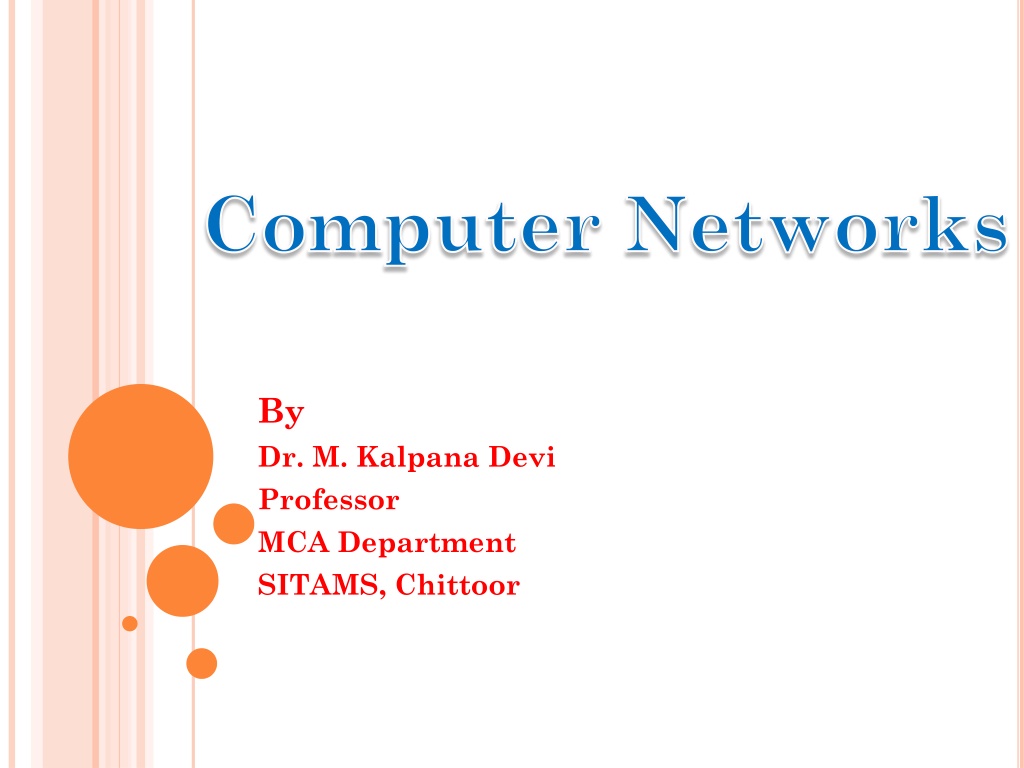
 undefined
undefined
























